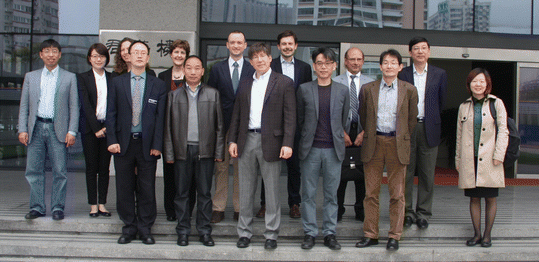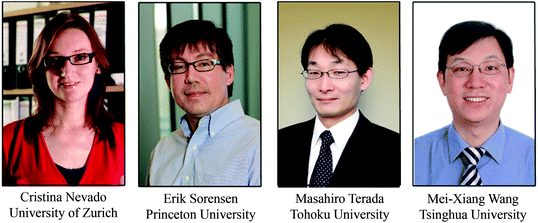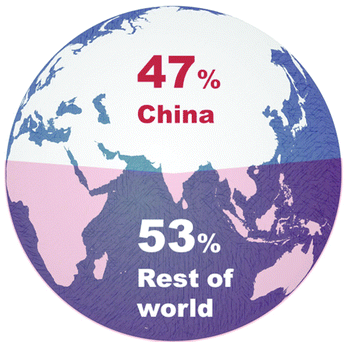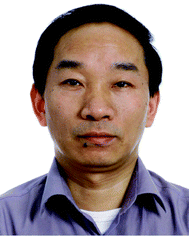A flying start to a bright future
Shengming Ma
It is hard to believe that we are already working with the second volume of Organic Chemistry Frontiers. Much ambition and enthusiasm have been infused into this new journal by our excellent team members who are working towards the original goal of the journal, namely to become a top-tier journal in the field of organic chemistry. It makes me feel proud, as I look back over 2014, seeing that Organic Chemistry Frontiers is gradually delivering its goals and earning recognition and rewards from the global chemistry community.Starting a new journal is hard; starting a new journal of high impact can only be harder. Organic Chemistry Frontiers was set to publish the best research from across organic chemistry. Ensuring a high quality of accepted papers is thus the top priority and the main challenge we have to face from the beginning. Thanks to the hard work of the Organic Chemistry Frontiers team and the authors’ confidence in the future of the journal, submissions to Organic Chemistry Frontiers exceeded our expectations and the number of published articles for the 10 issues published in 2014 was over 180. As more and more content was published, Organic Chemistry Frontiers has been bringing together many beautiful reports on catalysis, synthetic methodology, natural product synthesis, supramolecular chemistry, etc. We are also delighted to see many world renowned names appearing as Organic Chemistry Frontiers authors. For some examples of our great content, see Table 1 where we have collected the top-20 most-cited Organic Chemistry Frontiers articles since our launch. I hope that you will be impressed by their high quality and agree that the scientific content of Organic Chemistry Frontiers is in line with its aim to become one of the leading journals in the field of organic chemistry.
| Title | Authors | DOI |
|---|---|---|
| Transition-metal-free, room-temperature radical azidofluorination of unactivated alkenes in aqueous solution | Zhaodong Li, Chengwei Zhang, Lin Zhu, Chao Liu and Chaozhong Li | 10.1039/C3QO00037K |
| Iron-catalyzed/mediated oxidative transformation of C–H bonds | Fan Jia and Zhiping Li | 10.1039/C3QO00087G |
| Copper-catalyzed trifluoromethylthiolation of aryl and vinyl boronic acids with a shelf-stable electrophilic trifluoromethylthiolating reagent | Kai Kang, Chunfa Xu and Qilong Shen | 10.1039/C3QO00068K |
| Chiral N,N′-dioxide ligands: synthesis, coordination chemistry and asymmetric catalysis | Xiaohua Liu, Lili Lin and Xiaoming Feng | 10.1039/C3QO00059A |
| Catalytic fluorination of unactivated C(sp3)–H bonds | Jun-An Ma and Shen Li | 10.1039/C4QO00078A |
| A non-diazostrategy to cyclopropanation via oxidatively generated gold carbene: the benefit of a conformationally rigid P,N-bidentate ligand | Kegong Ji and Liming Zhang | 10.1039/C3QO00080J |
| Copper-catalyzed cross-coupling of bromozinc-difluoromethylphosphonate with iodo/bromo-aryl triazenes | Zhang Feng, Yu-Lan Xiao and Xingang Zhang | 10.1039/C3QO00044C |
| Recent advances in C–H fluorination | Aijun Lin, C. Bryan Huehls and Jiong Yang | 10.1039/C4QO00020J |
| Vanadium-catalyzed C(sp3)–H fluorination reactions | Ji-Bao Xia, Yuyong Ma and Chuo Chen | 10.1039/C4QO00057A |
| Palladium-catalyzed base-accelerated direct C–H bond alkenylation of phenols to synthesize coumarin derivatives | Xi-Sha Zhang, Zhao-Wei Li and Zhang-Jie Shi | 10.1039/C3QO00010A |
| Regiocontrolled 1,2-migration in cyclization of 1-(indol-2-yl)-3-alkyn-1-ols: (Ph3P)Au+vs. PtCl4 | YouaiQiu, Dengke Ma, Wangqing Kong, Chunling Fu and Shengming Ma | 10.1039/C3QO00006K |
| Palladium-catalysed regioselective hydroamination of 1,3-dienes: synthesis of allylic amines | Debasis Banerjee, Kathrin Junge and Matthias Beller | 10.1039/C4QO00023D |
| The redox-A3 reaction | Daniel Seidel | 10.1039/C4QO00022F |
| Benzoate dioxygenase from Ralstoniaeutropha B9 – unusual regiochemistry of dihydroxylation permits rapid access to novel chirons | Julia A. Griffen, Sarah J. Kenwright, Sarah Abou-Shehada, Scott Wharry, Thomas S. Moody and Simon E. Lewis | 10.1039/C3QO00057E |
| Direct activation of relatively unstrained carbon–carbon bonds in homogeneous systems | Alpay Dermenci, Jotham W. Coe and Guangbin Dong | 10.1039/C4QO00053F |
| N-alkylation of indole via ring-closing metathesis/isomerization/Mannich cascade under ruthenium/chiral phosphoric acid sequential catalysis | Yan-Chao Shi, Shou-Guo Wang, Qin Yin and Shu-Li You | 10.1039/C3QO00008G |
| Chiral primary amine catalysed asymmetric conjugate addition of azoles to α-substituted vinyl ketones | Niankai Fu, Long Zhang, Sanzhong Luo and Jin-Pei Cheng | 10.1039/C3QO00027C |
| Synthesis of semibullvalene derivatives via Co2(CO)8-mediated cyclodimerization of 1,4-dilithio-1,3-butadienes | Shaoguang Zhang, Ming Zhan, Qifeng Wang, Chao Wang, Wen-Xiong Zhang and Zhenfeng Xi | 10.1039/C3QO00019B |
| Singlet carbenes as mimics for transition metals: synthesis of an air stable organic mixed valence compound [M2(C2)+˙; M = cyclic (alkyl)(amino)carbene] | Liqun Jin, Mohand Melaimi, Liu Liu and Guy Bertrand | 10.1039/C4QO00072B |
| Highly stereoselective construction of adjacent tetrasubstituted carbon stereogenic centres via an organocatalytic Mukaiyama-aldol reaction of monofluorinated silyl enol ethers to isatins | Yun-Lin Liu, Fu-Min Liao, Yan-Fei Niu, Xiao-Li Zhao and Jian Zhou | 10.1039/C4QO00126E |
“The best research deserves the best publishing service”, that is why we keep working on shortening article processing times. Organic Chemistry Frontiers today has reached a competitive average time of 37 days from receipt to acceptance; in the shortest case, it only took 10 days for a manuscript to go through the full peer-review process. Special thanks are given to our Associate Editors for their great effort in handling manuscripts (Fig. 1), as well as to the referees for generously devoting their time to evaluating the scientific content of submissions. The journal would not succeed without your support.
As part of the community, Organic Chemistry Frontiers also has a substantial presence at leading chemistry conferences through attendance of either Editorial staff or Editorial Board members, to maximize our visibility and to capture the latest developments in the field.
2014 also saw the launch of the 1stOrganic Chemistry Frontiers International Symposium at the Shanghai Institute of Organic Chemistry, China (Fig. 2). 10 excellent talks were given over a one-day meeting by our exceptional Editorial Board members. Positive feedback was received from over a hundred audience members. The next symposium is planned for next April, coinciding with the 2015 Editorial Board meeting of the journal. Relevant news will be released on the blog (http://blogs.rsc.org/qo) closer to the time.
 | ||
| Fig. 2 Organic Chemistry Frontiers Editorial Board members and Editorial staff at the 1stOrganic Chemistry Frontiers International Symposium in Shanghai. | ||
To stand out from the vast number of other journals, Organic Chemistry Frontiers strives to develop something unique and innovative to meet the various needs of the scientific community. After introducing Research Articles, Tutorial Accounts and Reviews, the journal will be publishing another three article types, namely Methods, Profiles and Chemistry Frontiers.
• Methods will be independent technical notes from current Tutorial Accounts focusing on the practicality of methodologies.
• Profiles will be interviews of top scientists and a concise introduction to their original scientific work, showcasing the best of our authors.
• Chemistry Frontiers will be short, forward-looking articles by top scientists looking ahead to the future of fruitful research fields in organic chemistry.
We hope researchers from diverse subfields of organic chemistry will find Organic Chemistry Frontiers an ideal platform for the dissemination of their important research findings, and the scientific content of the journal will be of great interest to the broadest possible readership.
Organic Chemistry Frontiers is part of the ‘Frontiers’ portfolio, a series of chemistry journals combining high-quality content and fast publication times with the trusted values of society publishing. ‘Frontiers’ journals are developed under the unique not-for-profit partnership between the Chinese Chemical Society (CCS) and the Royal Society of Chemistry. Each journal title is in further collaboration with a top Chinese institute in the relevant field and is jointly owned by these three parties. For Organic Chemistry Frontiers, the partner institute is the Shanghai Institute of Organic Chemistry.
This collaboration between the CCS and the Royal Society of Chemistry celebrates a new phase in scientific growth. China is now ranked among the top countries in the world in scientific research: in 2013 China's total expenditure on research & development was 179 billion USD, putting it in second place after the United States. Almost 21% of the total organic chemistry publications in 2014, as indexed by the Web of Science, came from China, ranking no. 1 among all countries. Many of the articles published in Organic Chemistry Frontiers came from high-profile Chinese authors, most of whom are winners of the National Science Fund for Distinguished Young Scholars. But gathering the best research from the best Chinese authors is only a good start for Organic Chemistry Frontiers. Whilst treasuring the strong support from the Chinese community, we are also receiving a growing number of manuscripts from 17 other countries, including major forces in chemistry such as the US, UK, Japan, Germany and Singapore (Fig. 3).
Gratitude is given to all our authors, referees and readers for your invaluable support in helping us deliver our goal of advancing the science of organic chemistry. We invite you to submit your best work to Organic Chemistry Frontiers viahttp://rsc.li/frontiers-organic, where you will benefit from rapid publication, good global visibility and free access to the first two volumes.
Please follow the latest journal news via Twitter (@orgchemfront) and WeChat (orgchemfront), and do send us your feedback (OrgChemFrontiersED@rsc.org) to help improve the performance of the journal.
Enjoy reading Organic Chemistry Frontiers. We wish everyone an exciting and successful 2015!
(Editor-in-Chief)
| This journal is © the Partner Organisations 2015 |



